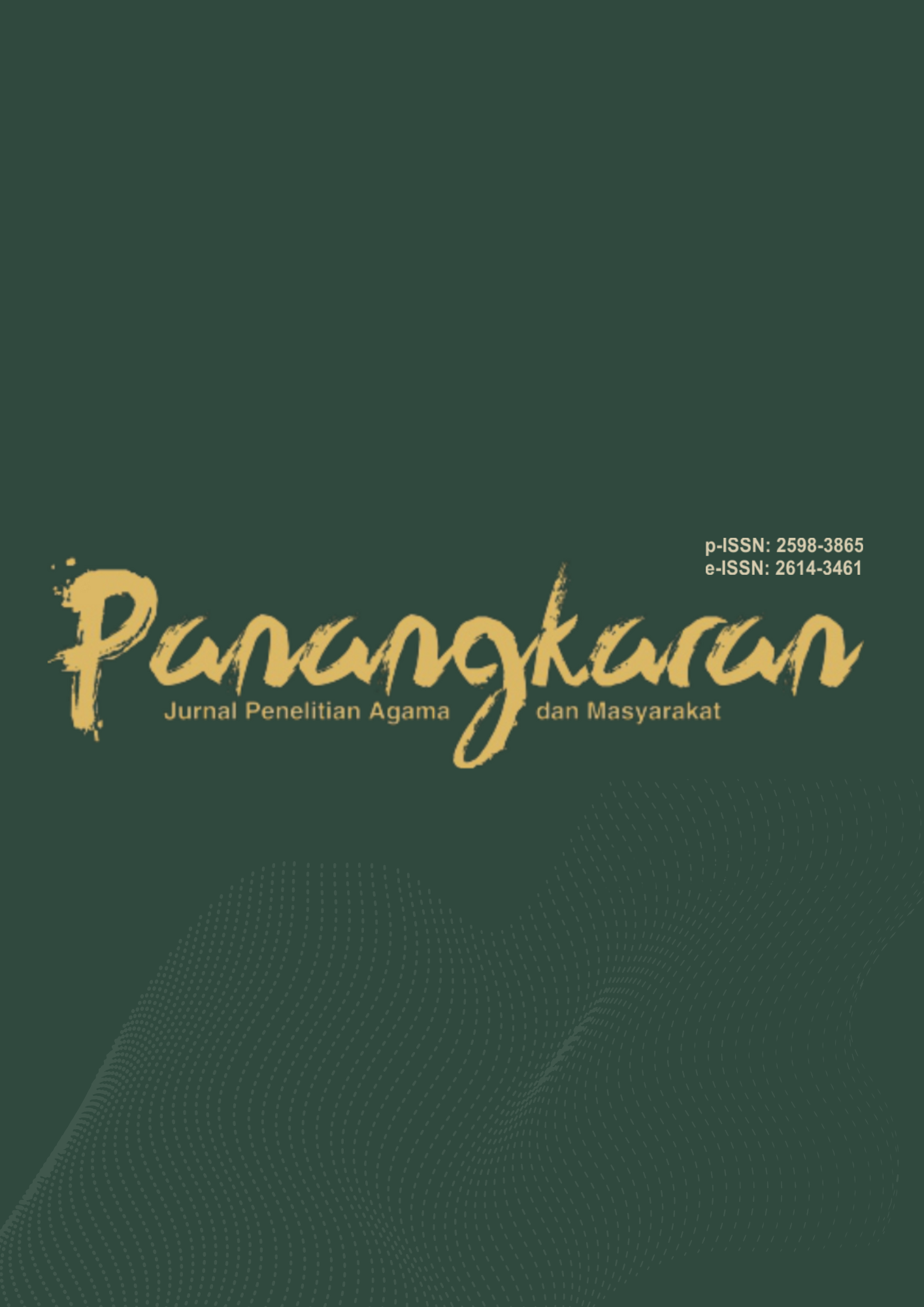Indigenous-based Resistance: Rethinking the Barambang Katute Indigenous Community's Agrarian Conflict with the Government Through the Indigenous Religion Paradigm
DOI:
https://doi.org/10.14421/panangkaran.v8i2.3680Keywords:
Agrarian Conflict, Indigenous Peoples, Indigenous Religion Paradigms, ResistanceAbstract
The government's development narrative often victimizes Indigenous Peoples in Indonesia. Indigenous forests, sacred places for the community, are sought to be legalized for development purposes. This paper is a crisis study of government policies that use the World Religion Paradigm in developing policies toward the Indigenous Peoples of Barambang Katute. This research aims to reveal Indigenous-based resistance from the Barambang Katute Indigenous Community against government and company policies in Sinjai Regency. This article uses the Indigenous Religion Paradigm as its analysis. This research uses a literature study by analyzing written literature on the conflict between Indigenous Peoples and the government in Sinjai Regency. The results of this study mention that resistance in the Barambang Katute Indigenous Community is not only seen from the economic, political, and ecological aspects but also from the socio-religious aspects. The next result framework is written as follows: First, it discusses the history of the causes of agrarian conflicts between indigenous peoples and the government of Sinjai Regency. Second, it discusses the relationship between the Barambang Katute Indigenous Community and nature. Third, it discusses custom-based resistance as the solidarity of indigenous peoples in defending traditional territories. Through the Indigenous Religion Paradigm, we can see that in the efforts to seize the customary forest of Barambang Katute, the government has experienced dynamics and a long journey of conflict. Thus, custom-based resistance is an alternative struggle in defending the existence of customary forests as part of the spirituality of the Barambang Katute Indigenous Community.
[Masyarakat Adat di Indonesia seringkali menjadi korban atas narasi pembangunan yang dilakukan oleh pemerintah. Hutan Adat yang merupakan tempat ‘sacred’ bagi masyarakat, diupayakan dilegalkan pemanfaatannya dengan alasan demi kepentingan pembangunan. Tulisan ini merupakan studi krisis terhadap kebijakan pemerintah yang menggunakan paradigma agama dunia dalam melakukan kebijakan pembangunan terhadap Masyarakat Adat Barambang Katute. Penelitian ini bertujuan untuk mengungkapkan resistensi berbasis Adat yang dilakukan oleh Masyarakat Adat Barambang Katute terhadap kebijakan pemerintah dan perusahaan di Kabupaten Sinjai. Secara jelas, artikel ini menggunakan Indigenous Religion Paradigm sebagai analisisnya. Penelitian ini menggunakan studi literatur dengan menganalisis literatur tertulis yang berhubungan dengan konflik Masyarakat Adat dengan pemerintah di Kabupaten Sinjai. Hasil penelitian ini menyebutkan bahwa resistensi dalam Masyarakat Adat Barambang Katute tidak hanya dilihat dari aspek ekonomi, politik dan ekologi melainkan juga dari aspek sosial-keagamaan. Berikutnya kerangka hasil ditulis sebagai berikut: Pertama, membahas tentang sejarah penyebab konflik agraria masyarakat adat dengan pemerintah Kabupaten Sinjai. Kedua, membahas tentang relasi Masyarakat Adat Barambang Katute dengan alam. Ketiga, membahas resistensi berbasis adat sebagai solidaritas masyarakat adat dalam mempertahankan wilayah adat. Melalui Paradigma Agama Leluhur kita dapat melihat upaya perampasan hutan adat Barambang Katute oleh Pemerintah telah mengalami dinamika dan perjalanan konflik yang panjang. Dengan demikian, Resistensi berbasis Adat merupakan alternatif perjuangan dalam mempertahankan eksistensi hutan adat sebagai bagian dari spiritualitas Masyarakat Adat Barambang Katute.]
Downloads
References
Alcorn, J. B. (1993). Indigenous Peoples and Conservation. In Conservation Biology (Vol. 7, Issue 2). https://doi.org/10.1046/j.1523-1739.1993.07020424.x
Alfian, A. (2022). Rediscovering ‘Sacred Place’ through the Indigenous Religion Paradigm: A Case Study of Bugis-Makassar Indigenous People. Al-Izzah: Jurnal Hasil-Hasil Penelitian. https://doi.org/10.31332/ai.v0i0.4187
Alfian, A. (2023). Masyarakat Adat dan Ideologi Pembangunan yang Gagal. Crcs.Ugm.Ac.Id.
Almujaddidy, A. I. (2022). Progressive Muslim Environmentalism: The Eco-Theology and Ethics of the Nahdliyyin Front For Sovereignty Over Natural Resources (FNKSDA). In Z. A. Bagir, M. S. Northcott, & F. Wijsen (Eds.), Varieties of Religion and Ecology: Dispatches from Indonesia (pp. 9–31). LIT Verlag Münster.
Arauf, M. (2021). Konsep Pengelolaan Hutan Adat di Indonesia: Sebuah Kasus di Bengkalis, Indonesia. Jurnal Cahaya Keadilan.
Arif, M., Mundzir, C., & Khairunnisa, A. K. (2022). Eksistensi Tradisi Mattiana Arajang di Desa Bonto Kecamatan Sinjai Tengah Kabupaten Sinjai ( Perspektif Budaya ). Jurnal Ilmu Budaya, 10, 202–210. https://doi.org/https://doi.org/10.34050/jib.v10i1.18264
Astiana, I. K., Sumarni, S., Felicia, M. Y., & Kurniawati, E. (2021). The Traditional Ceremonies of Tengger Tribe As A Sustainable Tourism Object in Indonesia. GeoJournal of Tourism and Geosites, 39(4 supplement), 1371–1378. https://doi.org/10.30892/gtg.394spl07-780
Badan Registrasi Masyarakat Adat. (2023). Wilayah Adat Masyarakat Adat Barambang Katute. Badan Registrasi Masyarakat Adat. https://brwa.or.id/wa/view/WDg2V3U2LUJaSkU
Bagir, Z. A. (2022). The Varieties of Religion and Ecology. In Z. A. Bagir, M. S. Northcott, & F. Wijsen (Eds.), Varieties of Religion and Ecology: Dispatches from Indonesia (pp. 1–8). LIT Verlag Münster.
Berkes, F. (2017). Sacred Ecology. In Sacred Ecology. https://doi.org/10.4324/9781315114644
(BNPB), B. N. P. B. (2023). Data Bencana Indonesia. Bnpb.Go.Id.
Cahyono, E. (2013). Eksklusi Atas Nama Konservasi (Studi Kasus Masyarakat Sekitar/dalam Kawasan Taman Nasional Ujungkulon Banten ). Sosiologi Reflektif, 8(1), 209–246.
Chandra, W. (2013, September 29). Nasib Masyarakat Adat Barambang Katute, dari Teror Penangkapan sampai Ancaman Tambang. Www.Mongabay.Co.Id.
Cox, J. L. (2007). From Primitive to Indigenous: The Academic Study of Indigenous Religious. Ashgate Publishing Company.
David, K. (2020). Ancestors and Martyrs: Religious Ceremonies of Occupation and Liberation in Ukraine. Ab Imperio, 2020(4), 161–191. https://doi.org/10.1353/imp.2020.0094
Fakih, M. (2002). Runtuhnya Teori Pembangunan dan Globalisasi. In Insist Press.
Gabriel, A. G., De Vera, M., & B. Antonio, M. A. (2020). Roles of indigenous women in forest conservation: A comparative analysis of two indigenous communities in the Philippines. Cogent Social Sciences, 6(1). https://doi.org/10.1080/23311886.2020.1720564
Gaol, H. S. L., & Hartono, R. N. (2021). Political will pemerintah terhadap pengelolaan hutan adat sebagai upaya penyelesaian konflik agraria. BHUMI: Jurnal Agraria Dan Pertanahan, 7(1), 42–56. https://doi.org/10.31292/bhumi.v7i1.468
Hakim, F. N. R. (2022). Redefining “Sacred” through the Indigenous Religion Paradigm: Case Study of Sunda Wiwitan Community in Kuningan. Religió: Jurnal Studi Agama-Agama, 12(1), 42–63. https://doi.org/10.15642/religio.v12i1.1859
Harianto, S., Hidayat, K., Sukesi, K., & Yuliati, Y. (2014). Characteristic and Social Processes of Poverty Reduction in Rural Community: An Empirical Finding. Humanities and Social Sciences, 4(3).
Harvey, G. (2022). Belonging to (Not “in”) Land as Performed at Indigenous Cultural Events. Material Religion, 18(1), 16–31. https://doi.org/10.1080/17432200.2021.2018849
Hutauruk, A. F., & Ginting, A. M. (2019). Pemerintahan Nagori Rabuhit 1968-2017. Criksetra: Jurnal Pendidikan Sejarah, 8(2), 41–57. https://doi.org/10.36706/jc.v8i2.9246
Johnson, K. A., Weinberger, A. B., Dyke, E., Porter, G. F., Kraemer, D. J. M., Grafman, J., Cohen, A. B., & Green, A. E. (2023). Differentiating personified, supernatural, and abstract views of God across three cognitive domains. Psychology of Religion and Spirituality, 15(1), 128–142. https://doi.org/10.1037/rel0000460
Kamaruddin, K., Najamuddin, N., & Patahuddin, P. (2018). Menjaga Tanah Leluhur: Aliansi Masyarakat Adat Nusantara di Sulawesi Selatan 2003-2016. Jurnal Pattingalloang, 5(1), 121. https://doi.org/10.26858/pattingalloang.v5i1.6726
Kandzior, A. (2016). Indigenous people and forests. In Tropical Forestry Handbook, Second Edition (Vol. 4). https://doi.org/10.1007/978-3-642-54601-3_269
kemitraan.or.id. (2022, September 30). Berharap Pengakuan Hutan Adat. Kemitraan Partnership.
Kurniawan, A. H. (2013). Persistensi dan Resistensi Masyarakat Terhadap Eksistensi Pertambangan Emas di Desa Bonto Katute Kabupaten Sinjai. Universitas Hasanuddin.
Maarif, S. (2015). Ammatoan Indigenous Religion and Forest Conservation. Worldviews, 19(2), 144–160. https://doi.org/10.1163/15685357-01902005
Maarif, S. (2019). Indigenous Religion Paradigm : Re-interpreting Religious Practices of Indigenous People. Studies In Philosphy, 44, 56(103)-38(121). https://doi.org/10.15068/00155157
Maarif, S. (2021). Re-Establishing Human-Nature Relations: Responses of Indigenous People of Indonesia to Covid-19. Interdisciplinary Journal for Religion and Transformation in Contemporary Society, 7(2). https://doi.org/10.30965/23642807-bja10023
Manik, K. U., Sumertha, I. G., & Widodo, P. (2023). Implementing elements of national security by fulfilling the rights of indigenous people of Laman Kinipan in Central Kalimantan (Indonesia). Defense and Security Studies, 4, 29–35. https://doi.org/10.37868/dss.v4.id231
Misran, M., Asriadi, A., Abhipraya, F. A., Isolana, J. B., Evendi, D., & Faisal, A. (2023). A Case Study on Wadas Community Social Movement : Community Resistance Movement Against Mining Development. Humanus: Jurnal Ilmiah Ilmu-Ilmu Humaniora, 22, 12–27. https://doi.org/10.24036/humanus.v22i1.117031
Morrison, K. M. (2000). The Cosmos as Intersubjective: Native American Other-Than-Human. Indigenous Religions: A Companion, 23.
Muhannis, M. (2022). Hanua Sinjai (K. Pabichara, Ed.). Penerbit Ininnawa.
Nababan, A. (2002). Revitalisasi Hukum Adat untuk Menghentikan Penebangan Hutan secara “Illegal” di Indonesia. The Revitalization of Customary Law to Stop Illegal Logging in Indonesia’). Jakarta: Aliansi Masyarakat Adat Nusantara.
Najihudin, A., Khoerunisa, S., Syarifulbanat, E., Suryani, F., Apriyani, F., & Apriyani, F. (2022). The Effect Of Education On The Utilization Of Kitchen Seasoning As Infused Water To Increase The Immunity Of The Community Of Sukamukti Village. Indonesian Journal of Community Empowerment (IJCE), 3(02). https://doi.org/10.35899/ijce.v3i02.456
Northcott, M. (2020). COVID-19, human ecology and the ontological turn to Gaia. In Pandemic, Ecology and Theology. https://doi.org/10.4324/9781003105602-9
Northcott, M. S. (2015a). Place, ecology and the sacred: the moral geography of sustainable communities. Bloomsbury Publishing.
Northcott, M. S. (2015b). Place, Ecology and the Sacred: The Moral Geography of Sustainable Communities. Bloomsbury Publishing.
Nurfahmi. (2018). Tata Kelola Konflik Eksplorasi Tambang (Study Kasus Masyarakat Dan PT.Galena Sumber Energi) di Desa Bontokatute Kecamatan Sinjai Borong Kabupaten Sinjai. Universitas Muhammadiyah Makassar.
Nurlinda, N., Ridha, R., & Amirullah, A. (2019). Konflik Kawasan Hutan Barambang Katute Kabupaten Sinjai (1994-2012). Jurnal Pattingalloang, 6(1), 70. https://doi.org/10.26858/pattingalloang.v6i1.10685
Pratama, M. N. (2019). Analisis Program Raskin dalam Meningkatkan Kesejahteraan Masyarakat di Kelurahan Hegarsari Kecamatan Pataruman Kota Banjar Tahun 2017. Jurnal Ilmu Politik Dan Pemerintahan, 5(1), 8–17.
Qin, Y., Xiao, X., Liu, F., de Sa e Silva, F., Shimabukuro, Y., Arai, E., & Fearnside, P. M. (2023). Forest conservation in Indigenous territories and protected areas in the Brazilian Amazon. Nature Sustainability. https://doi.org/10.1038/s41893-022-01018-z
Rahman, R. (2017). Konflik Masyarakat Dengan Pemerintah (Studi Kasus Sengketa Tanah Adat). Sosioreligius, 2(1), 41–48. https://doi.org/https://doi.org/10.24252/sosioreligius.v2i1.5997
Reyes, R., & Nelson, H. (2014). A tale of two forests: why forests and forest conflicts are both growing in Chile. International Forestry Review, 16(4), 379–388. https://doi.org/10.1505/146554814813484121
Ross, A. (2016). Michael S. Northcott. Place, Ecology and the Sacred: The Moral Geography of Sustainable Communities. . Studies in World Christianity, 22(1). https://doi.org/10.3366/swc.2016.0139
Sastra Hadi, E., & Vidya Putra, E. (2019). Resistensi Masyarakat terhadap Rencana Pembangunan PLTP (Pembangkit Listrik Tenaga Panas Bumi) Di Gunung Talang Kabupaten Solok. Jurnal Perspektif, 2(3), 236. https://doi.org/10.24036/perspektif.v2i3.95
Soemardjan, S. (1962). Land Reform in Indonesia. Asian Survey, 1(12), 23–30. https://doi.org/10.2307/3023456
Tahir, M., Abrahim, A., Beyene, T., Dinsa, G., Guluma, T., Alemneh, Y., Van Damme, P., Geletu, U. S., & Mohammed, A. (2023). The traditional use of wild edible plants in pastoral and agro-pastoral communities of Mieso District, eastern Ethiopia. Tropical Medicine and Health, 51(1), 10. https://doi.org/10.1186/s41182-023-00505-z
tempo.co. (2006, June 22). Banjir Melanda Sinjai, 116 Tewas. Koran Tempo.
Tuck-Po, L. (2005). The meanings of trees: Forest and identity for the Batek of Pahang, Malaysia. The Asia Pacific Journal of Anthropology, 6(3), 249–261.
Umbu Deta, K. (2021). Marapu Resisting the Corporation to Protect the Land. Satya Widya: Jurnal Studi Agama, 4(2), 50–66. https://doi.org/10.33363/swjsa.v4i2.765
Usboko, I. (2016). Role Players Analysis dalam Konflik Pengelolaan Sumber Daya Alam (Studi Kasus Konflik Pertambangan Mangan Di Kabupaten Timor Tengah Selatan, Provinsi Nusa Tenggara Timur Tahun 2010-2011). Politika: Jurnal Ilmu Politik, 7(1), 16–36.
Weatherdon, M., & Schermerhorn, S. (2022). Movement and Indigenous Religions: A Reconsideration of Mobile Ways of Knowing and Being. Material Religion, 18(1), 3–15. https://doi.org/10.1080/17432200.2021.2015921
Widihastuti, S. (2018). Pengingkaran Hak Masyarakat Adat Atas Tanah Ulayat oleh Kebijakan Kehutanan. HUMANIKA, 8(1). https://doi.org/10.21831/hum.v8i1.21006
Laws and Regulations
Constitution, namely Article 18B paragraph (2) and Article 28I paragraph (3)
Law No. 5 of 1960 on the Basic Regulation of Agrarian Principles or UUPA
Law No. 5 of 1967 concerning Basic Provisions of Forestry (UUPK),
Law No. 41/1999 on Forestry
Constitutional Court (MK) No. 35/PUU-X/2012 on "Land Rights of Customary Law Communities"
Downloads
Published
How to Cite
Issue
Section
License
Copyright (c) 2024 Muammar

This work is licensed under a Creative Commons Attribution-NonCommercial-NoDerivatives 4.0 International License.
JURNAL PANANGKARAN disebarluaskan dengan lisensi Creative Commons Attribution-NonCommercial-NoDerrivatives 4.0 International License.
 Abstract Viewed = 282 times
|
Abstract Viewed = 282 times
|
 PDF downloaded = 202 times
PDF downloaded = 202 times












